|
Hawaii is the most isolated population center on Earth. It is 2,390 miles (3,850 km) from California, 3,850 miles (6,195 km) from Japan and 4,900 miles (7,885 km) from China.
The state of Hawaii consists of eight larger, populated islands and 124 small, uninhabited islands, reefs and atolls stretching from the Big Island in the south to the Kure Atoll in the northwest.
The Hawaiian archipelago spans the distance of 1,524 miles (2,451 km) making Hawaii the longest island chain in the world.
The highest recorded temperature in Hawaii is 100 degrees Fahrenheit (37.8 C), measured in Pahala on April 27, 1931, and the lowest is 12 degrees Fahrenheit (-11.1 C), measured on Mauna Kea on May 17, 1979. (The lowest temperature under 3,000 feet (914 m) altitude was 56 F/13.3 C). Among all the 49 continental United States (except Alaska), Hawaii has both the highest state minimum of 12 F (-11.1 C) and the lowest state maximum of 100 F (37.8 C). (Alaska’s highest recorded temperature is also 100 F/37.8 C). Hawaii’s average daytime temperature in July is 82 F (27.7 C) and the average daytime temperature in January is 72 F (22.2 C).
Hawaii was the 50th state admitted to the union on August 20, 1959.
By a legislative act, Hawaii became officially known as the “Aloha State” in 1959.
When measured from east to west, Hawaii is the widest state in the United States.
Hawaii has the highest population density in the United States.
Hawaii is the only U.S. state that grows coffee. Coffee plantations in Hawaii make up 6,200 acres. In 2003, 8.5 million pounds of coffee were produced.
Sugar is mainly produced on Maui and Kauai, on altogether 70,000 acres. In 2002, 340,000 tons of raw sugar were produced. One ton of water is needed to make a pound of sugar.
Hawaii produces about 320,000 tons of pineapple each year.
Hiram Fong of Hawaii was the first Asian-American in the Unites States Senate. Fong is a descendant from Chinese immigrants and was elected to the Senate in 1959.
In the 2000 census, more than 20 percent of Hawaii’s population claimed multi-ethnic backgrounds, far more than any other U.S. state.
Hawaii has its own time zone. It’s called Hawaiian Standard Time. There is no daylight savings time in Hawaii, which means that in summer, Hawaii is two hours behind the U.S. West Coast, while in winter, Hawaii is three hours behind the U.S. West Coast.
The state of Hawaii has four counties: City and county of Honolulu, Kauai, Maui and Hawaii (the Big Island).
The Hawaiian alphabet consists of only twelve letters. The five vowels are A,E, I, O,U. And the seven consonants are H,K,L,M,N,P,W.
Hawaii is the only U.S. state whose land area is increasing (from volcanic eruptions).
Hawaii is the only U.S. state whose majority of people are non-white.
Among all U.S. states, Hawaii has the highest percentage of women in the workforce, about 63 percent as of 2003.
More birds have become extinct in Hawaii than in any other part of the world. A total of 26 species died out and 27 more are endangered by changes in their natural habitats, forest destruction, mongooses and man.
The Hawaiian Islands National Wildlife Refuge northwest of Kauai is the world’s largest bird sanctuary. It is home to many seabirds.
Hawaii had the oldest newspaper west of the Rocky Mountains – the Sandwich Island Gazette, 1836-1839.
Hawaii has the highest number of married couples living with others, mainly because Hawaii has the lowest percentage of home ownership.
Hawaii has the highest life expectancy in the United States. Life expectancy for males is 75, for females 80 years.
Hawaii has the fewest overweight people in the United States. About 19.7 percent of Hawaii residents are overweight, compared to about 30 percent on the mainland.
Oahu Fun Facts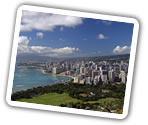
Honolulu is the “largest” city in the world. That’s because Hawaii’s state constitution states that any island not named as belonging to a county belongs to Honolulu. This makes the entire island of Oahu, where Honolulu is located, plus all the other small, uninhabited islands, known as the Northwestern Hawaiian Islands, part of Honolulu. Honolulu is about 1,500 miles (2,414 km) long. Or in other words, it spans the distance from Los Angeles, California, to Denver, Colorado.
Oahu is home to the world’s largest wind generator. The windmill is located on the top of a 20-story tower. It has two blades, each measuring 400 feet (122 m) in length.
Foster Botanical Garden near Iolani Palace was built in 1855, which makes it the oldest garden in Hawaii.
Waikiki attracts 72,000 visitors on any given day. That’s as much as 44 percent of all tourists present in the entire state of Hawaii.
Iolani Palace, located in downtown Honolulu, is the only royal palace in the United States.
Electric lights illuminated Iolani Palace four years before the White house had them.
Honolulu is the second most expensive city in the United States, after Anchorage, Alaska.
Maui Fun Facts
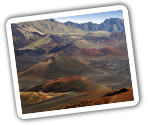 Haleakala Crater on the island of Maui is the world's largest dormant volcano. Haleakala Crater on the island of Maui is the world's largest dormant volcano.
Hawaii has many plants that are endemic to the islands. One of the best-known is the Haleakala silversword on Maui, which only grows in a 1,000 ha (2,471 acre) area at an elevation of 6,890 to 9,843 feet (2,100 to 3,000 m) within the Haleakala National Park. The silversword flowers only once at the end of its lifetime. It takes about 15 to 50 years to grow.
Hawaii has the oldest school west of the Rocky Mountains. It was founded in Lahaina in 1831.
The famous Road to Hana on Maui’s north shore is a 55-mile long, narrow road and features 617 curves and 26 bridges. It has some of the most breathtaking oceanfront scenery.
Kauai Fun Facts
The island of Kauai is home to the wettest spot on Earth. The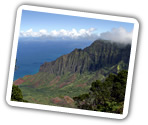 average yearly rainfall on Mt. Waialeale is about 397 inches (10 m). average yearly rainfall on Mt. Waialeale is about 397 inches (10 m).
Kauai is home to Waimea Canyon, also known as the “Grand Canyon of the Pacific.” It measures about 3,000 feet (914 m) in depth and 12 miles (19.3 km) in length.
Kauai is the oldest of the main Hawaiian Islands. It’s over six million years old.
By law, no building on Kauai is allowed to be built taller than a palm tree.
Kauai, also known as the “Garden Isle,” is famous for its jagged green mountains, white-sand beaches and tropical landscapes. More than 60 Hollywood movies have been filmed here, including Jurassic Park, Outbreak, Blue Hawaii and the TV shows Fantasy Island and Gilligan’s Island.
Big Island Fun Facts
Not only is the Big Island the largest of all the Hawaiian Islands (it’s more 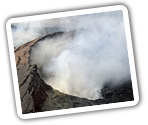 then twice the size of all the other islands combined), but it’s also home to the largest contiguous ranch in the United States. Parker Ranch near Kamuela is 480,000 acres big. then twice the size of all the other islands combined), but it’s also home to the largest contiguous ranch in the United States. Parker Ranch near Kamuela is 480,000 acres big.
Ka Lae on the Big Island of Hawaii is the southernmost point in the United States. Visit here and you’ll notice a constant 27 knots per hour wind blowing east to west, 24 hours per day and 365 days per year.
Kilauea volcano on the Big Island is the largest and most active volcano in the world.
The Big Island’s Mauna Kea is the tallest mountain in the world when measured from its base at the ocean floor. It rises 13,796 feet (4,205 m) above sea level and another 17,000 feet (5,181 m) extend to its base below the ocean’s surface.
The Big Island of Hawaii is home to the world’s biggest telescope. It’s located on the top of Mauna Kea. The Mauna Kea Observatory is at an altitude of 13,796 feet (4,205 m).
Lake Waiau on the Big Island is the highest lake in the United States. It’s located at an altitude of 13,020 feet (3,968 m). It is 12,000 years old.
The Big Island of Hawaii is the worldwide leader in harvesting macadamia nuts and orchids.
The tallest coconut tree stands in Hilo and measures 92 feet and 5 inches (28.17 m).
Molokai Fun Facts
Molokai’s north s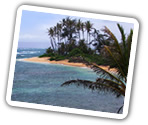 hore is home to the world’s largest sea cliffs (more than 3,000 ft/914 m high), Hawaii’s longest waterfall (Kahiwa Falls – 2,165 ft/660 m tall) and Hawaii’s longest white-sand beach (Papohaku Beach – about 3 miles (4.8 km) long). hore is home to the world’s largest sea cliffs (more than 3,000 ft/914 m high), Hawaii’s longest waterfall (Kahiwa Falls – 2,165 ft/660 m tall) and Hawaii’s longest white-sand beach (Papohaku Beach – about 3 miles (4.8 km) long).
Kalaaupapa on Molokai was once a leper colony. It was administered by Father Damien, a Flemish Catholic missionary, who later died of leprosy himself in 1889.
There are no traffic lights or shopping malls on Molokai.
The largest rubber-lined water reservoir in the world is in Kualapuu. It can hold over one billion gallons of water.
The first Hawaiian fossils were discovered in sandstone at the Moomomi Dunes.
Lanai Fun Facts
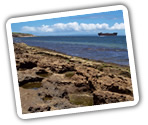 The island of Lanai was once the home of the world's largest pineapple plantations. At one point, the island was producing 75 percent of the world's pineapple. The island of Lanai was once the home of the world's largest pineapple plantations. At one point, the island was producing 75 percent of the world's pineapple.
In ancient times, it was assumed that evil spirits rule the island of Lanai. Kaululaau, a young man and son of a Maui chief was sent to Lanai to investigate the island and deem it free of evil spirits to make it suitable for settling.
Lanai has only three paved roads.
Kahoolawe Fun Facts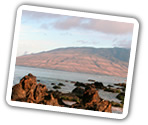
The island of Kahoolawe was once used as a target by the United States Navy and Air Force. It is uninhabited and up until today, it is off-limits to visitors. Kahoolawe has been returned to the state in 1994 and is currently being cleaned up by the U.S. government.
On March 18, 1981, Kahoolawe was added to the National Register of Historic Places. At that time, the island was home to 544 recorded archaeological or historic sites.
Niihau Fun Facts
Niihau is Hawaii’s “Forbidden Isle.” It’s a p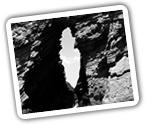 rivately-owned island and access by the general public is highly limited. The island’s population is 230. rivately-owned island and access by the general public is highly limited. The island’s population is 230.
Niihau is owned by the Robinson family, whose ancestors bought it from King Kamehameha IV over 100 years ago. One can only visit it by invitation from the owners or one of the Native Hawaiians who live there.
Northwestern Hawaiian Islands Fun Facts
The coral reefs in the Northwestern Hawaiian Islands make up about 70 percent of all the reefs in the United States.
The Northwestern Hawaiian Islands are a National Monument since June 15, 2006, when George W. Bush issued a public proclamation that created the Northwestern Hawaiian Islands National Monument under the Antiquities Act of 1906. The Monument includes all islands and surrounding waters, making it the largest marine wildlife reserve in the world. It encompasses 139,000 square miles of ocean. That's about the size of California.
The Northwestern Hawaiian Islands are home to more than 7,000 marine species, a quarter of which are found nowhere else in the world. One such marine species are the approximately 1,400 surviving Hawaiian monk seals, which is the entire population of this endangered species. The archipelago is also the breeding ground for 90 percent of the endangered Hawaiian green sea turtle. Huge schools of fish, many seabirds and an enormous coral reef can also be found on these islands.
|
